
Persei-Aries War Resumes
Gettysburg and Damascus Class Heavy Cruisers
Good afternoon ~ As promised (threatened 🙂 ) – here are the design sheets, write-ups, and Warship Record Sheets (WRS) for the new heavy cruiser classes that made their combat debut this past weekend, the American Gettysburg class heavy cruiser, and the Arab League’s Damascus class heavy hybrid cruiser.
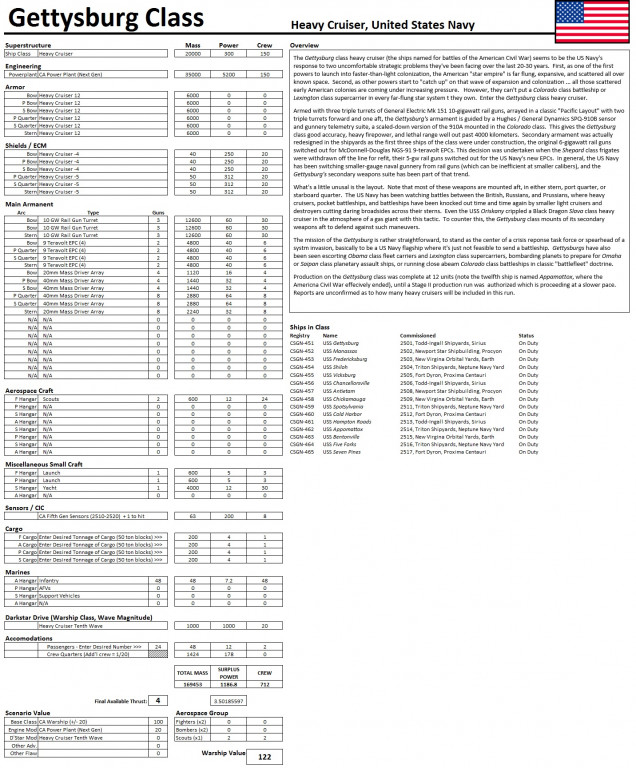 The Gettysburg class heavy cruiser (the ships named for battles of the American Civil War) seems to be the US Navy's response to two uncomfortable strategic problems they've been facing over the last 20-30 years. First, as one of the first powers to launch into faster-than-light colonization, the American "star empire" is far flung, expansive, and scattered all over known space. Second, as other powers start to "catch up" on that wave of expansion and colonization ... all those scattered early American colonies are coming under increasing pressure. However, they can't put a Colorado class battleship or Lexington class supercarrier in every far-flung star system t they own. Enter the Gettysburg class heavy cruiser. Armed with three triple turrets of General Electric Mk 151 10-gigawatt rail guns, arrayed in a classic "Pacific Layout" with two triple turrets forward and one aft, the Gettysburg's armament is guided by a Hughes / General Dynamics SPQ-910B sensor and gunnery telemetry suite, a scaled-down version of the 910A mounted in the Colorado class. This gives the Gettysburg class good accuracy, heavy firepower, and lethal range well out past 4000 kilometers. Secondary armament was actually redesigned in the shipyards as the first three ships of the class were under construction, the original 6-gigawatt rail guns switched out for McDonnell-Douglas NGS-91 9-teravolt EPCs. This decision was undertaken when the Shepard class frigates were withdrawn off the line for refit, their 5-gw rail guns switched out for the US Navy's new EPCs. In general, the US Navy has been switching smaller-gauge naval gunnery from rail guns (which can be inefficient at smaller calibers), and the Gettysburg's secondary weapons suite has been part of that trend.
The Gettysburg class heavy cruiser (the ships named for battles of the American Civil War) seems to be the US Navy's response to two uncomfortable strategic problems they've been facing over the last 20-30 years. First, as one of the first powers to launch into faster-than-light colonization, the American "star empire" is far flung, expansive, and scattered all over known space. Second, as other powers start to "catch up" on that wave of expansion and colonization ... all those scattered early American colonies are coming under increasing pressure. However, they can't put a Colorado class battleship or Lexington class supercarrier in every far-flung star system t they own. Enter the Gettysburg class heavy cruiser. Armed with three triple turrets of General Electric Mk 151 10-gigawatt rail guns, arrayed in a classic "Pacific Layout" with two triple turrets forward and one aft, the Gettysburg's armament is guided by a Hughes / General Dynamics SPQ-910B sensor and gunnery telemetry suite, a scaled-down version of the 910A mounted in the Colorado class. This gives the Gettysburg class good accuracy, heavy firepower, and lethal range well out past 4000 kilometers. Secondary armament was actually redesigned in the shipyards as the first three ships of the class were under construction, the original 6-gigawatt rail guns switched out for McDonnell-Douglas NGS-91 9-teravolt EPCs. This decision was undertaken when the Shepard class frigates were withdrawn off the line for refit, their 5-gw rail guns switched out for the US Navy's new EPCs. In general, the US Navy has been switching smaller-gauge naval gunnery from rail guns (which can be inefficient at smaller calibers), and the Gettysburg's secondary weapons suite has been part of that trend. 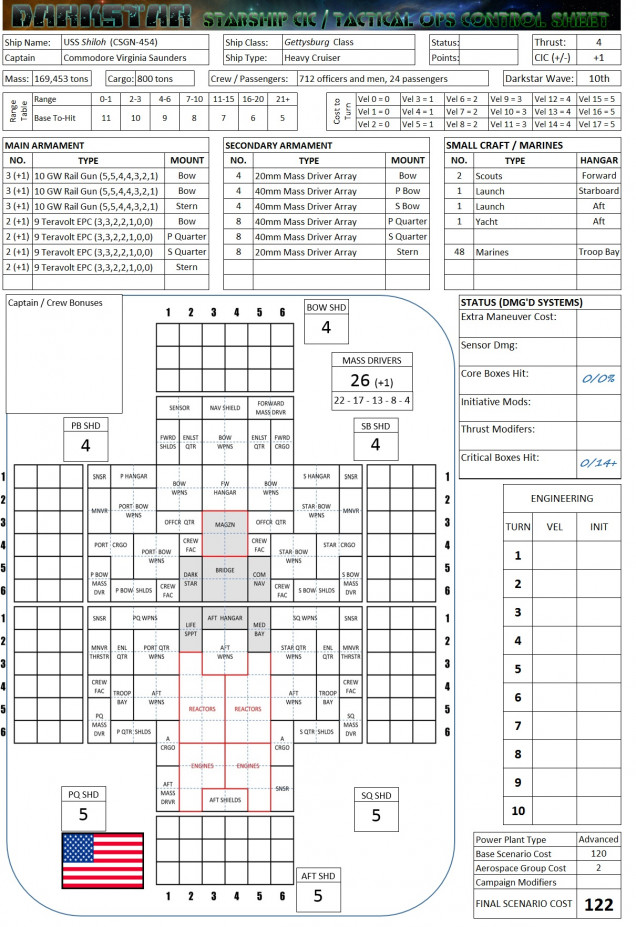 What's a little unusal is the layout. Note that most of these weapons are mounted aft, in either stern, port quarter, or starboard quarter. The US Navy has been watching battles between the British, Russians, and Prussians, where heavy cruisers, pocket battleships, and battleships have been knocked out time and time again by smaller light cruisers and destroyers cutting daring broadsides across their sterns. Even the USS Oriskany crippled a Black Dragon Slava class heavy cruiser in the atmosphere of a gas giant with this tactic. To counter this, the Gettysburg class mounts of its secondary weapons aft to defend against such maneuvers. The mission of the Gettysburg is rather straightforward, to stand as the center of a crisis reponse task force or spearhead of a systm invasion, basically to be a US Navy flagship where it's just not feasible to send a battleship. Gettysburgs have also been seen escorting Obama class fleet carriers and Lexington class supercarriers, bombarding planets to prepare for Omaha or Saipan class planetary assault ships, or running close abeam Colorado class battleships in classic "battlefleet" doctrine. Production on the Gettysburg class was complete at 12 units (note the twelfth ship is named Appamattox, where the Americna Civil War effecively ended), until a Stage II production run was authorized which is proceeding at a slower pace. Reports are unconfirmed as to how many heavy cruisers will be included in this run.
What's a little unusal is the layout. Note that most of these weapons are mounted aft, in either stern, port quarter, or starboard quarter. The US Navy has been watching battles between the British, Russians, and Prussians, where heavy cruisers, pocket battleships, and battleships have been knocked out time and time again by smaller light cruisers and destroyers cutting daring broadsides across their sterns. Even the USS Oriskany crippled a Black Dragon Slava class heavy cruiser in the atmosphere of a gas giant with this tactic. To counter this, the Gettysburg class mounts of its secondary weapons aft to defend against such maneuvers. The mission of the Gettysburg is rather straightforward, to stand as the center of a crisis reponse task force or spearhead of a systm invasion, basically to be a US Navy flagship where it's just not feasible to send a battleship. Gettysburgs have also been seen escorting Obama class fleet carriers and Lexington class supercarriers, bombarding planets to prepare for Omaha or Saipan class planetary assault ships, or running close abeam Colorado class battleships in classic "battlefleet" doctrine. Production on the Gettysburg class was complete at 12 units (note the twelfth ship is named Appamattox, where the Americna Civil War effecively ended), until a Stage II production run was authorized which is proceeding at a slower pace. Reports are unconfirmed as to how many heavy cruisers will be included in this run.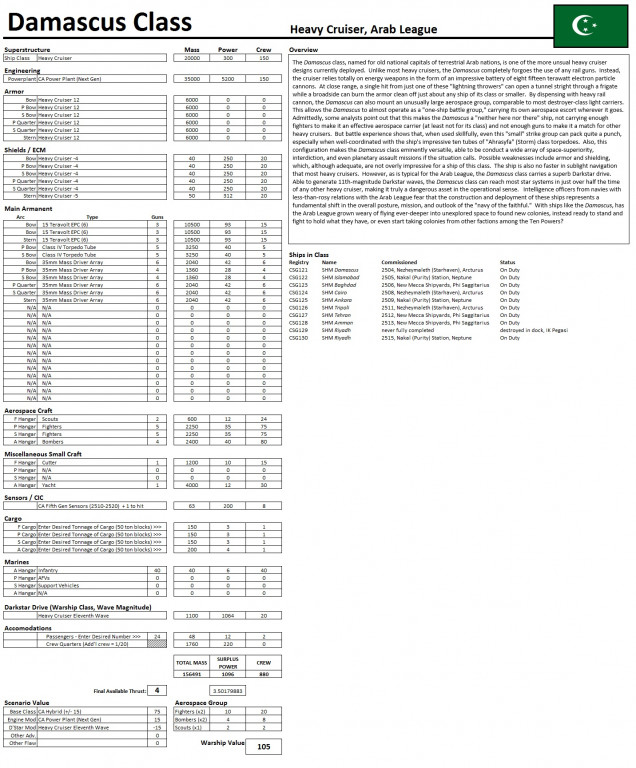 The Damascus class, named for old national capitals of terrestrial Arab nations, is one of the more unsual heavy cruiser designs currently deployed. Unlike most heavy cruisers, the Damascus completely forgoes the use of any rail guns. Instead, the cruiser relies totally on energy weapons in the form of an impressive battery of eight fifteen terawatt electron particle cannons. At close range, a single hit from just one of these "lightning throwers" can open a tunnel stright through a frigate while a broadside can burn the armor clean off just about any ship of its class or smaller. By dispensing with heavy rail cannon, the Damascus can also mount an unusually large aerospace group, comparable to most destroyer-class light carriers. This allows the Damascus to almost operate as a "one-ship battle group," carrying its own aerospace escort wherever it goes. Admittedly, some analysts point out that this makes the Damascus a "neither here nor there" ship, not carrying enough fighters to make it an effective aerospace carrier (at least not for its class) and not enough guns to make it a match for other heavy cruisers. But battle experience shows that, when used skillfully, even this "small" strike group can pack quite a punch, especially when well-coordinated with the ship's impressive ten tubes of "Ahrasyfa" (Storm) class torpedoes.
The Damascus class, named for old national capitals of terrestrial Arab nations, is one of the more unsual heavy cruiser designs currently deployed. Unlike most heavy cruisers, the Damascus completely forgoes the use of any rail guns. Instead, the cruiser relies totally on energy weapons in the form of an impressive battery of eight fifteen terawatt electron particle cannons. At close range, a single hit from just one of these "lightning throwers" can open a tunnel stright through a frigate while a broadside can burn the armor clean off just about any ship of its class or smaller. By dispensing with heavy rail cannon, the Damascus can also mount an unusually large aerospace group, comparable to most destroyer-class light carriers. This allows the Damascus to almost operate as a "one-ship battle group," carrying its own aerospace escort wherever it goes. Admittedly, some analysts point out that this makes the Damascus a "neither here nor there" ship, not carrying enough fighters to make it an effective aerospace carrier (at least not for its class) and not enough guns to make it a match for other heavy cruisers. But battle experience shows that, when used skillfully, even this "small" strike group can pack quite a punch, especially when well-coordinated with the ship's impressive ten tubes of "Ahrasyfa" (Storm) class torpedoes. 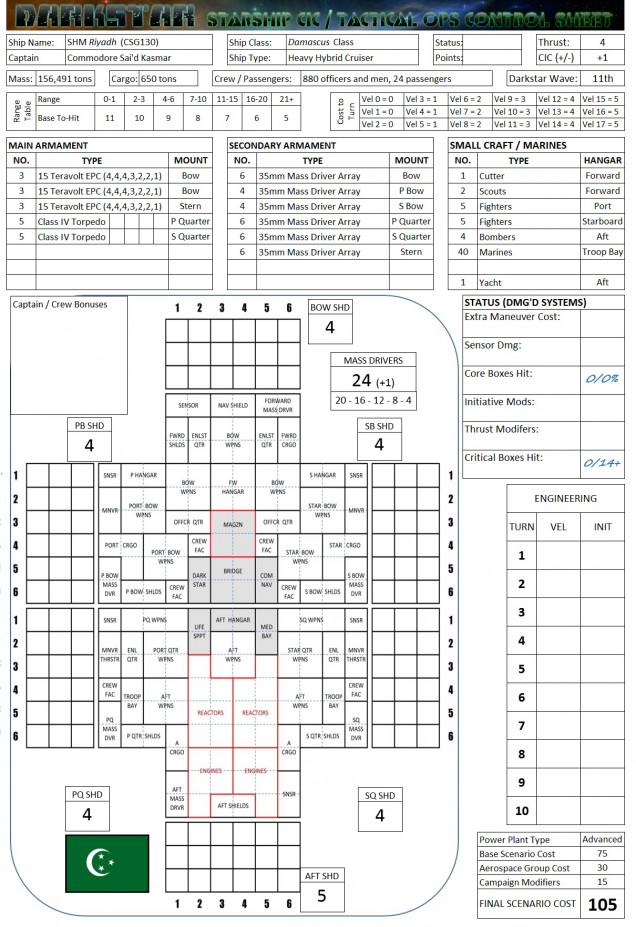 The weapons configuration of the Damascus class has been tailored with versatility in mind, and the ship is able to be conduct a wide array of space-superiority, interdiction, and even planetary assault missions if the situation calls. Possible weaknesses include armor and shielding, which, although adequate, are not overly impressive for a ship of this class. The ship is also no faster in sublight navigation that most heavy cruisers. However, as is typical for the Arab League, the Damascus class carries a superb Darkstar drive. Able to generate 11th-magnitude Darkstar waves, the Damascus class can reach most star systems in just over half the time of any other heavy cruiser, making it truly a dangerous asset in the operational sense. Intelligence officers from navies with less-than-rosy relations with the Arab League fear that the construction and deployment of these ships represents a fundamental shift in the overall posture, mission, and outlook of the "navy of the faithful." With ships like the Damascus, has the Arab League grown weary of flying ever-deeper into unexplored space to found new colonies, instead ready to stand and fight to hold what they have, or even start taking colonies from other factions among the Ten Powers?
The weapons configuration of the Damascus class has been tailored with versatility in mind, and the ship is able to be conduct a wide array of space-superiority, interdiction, and even planetary assault missions if the situation calls. Possible weaknesses include armor and shielding, which, although adequate, are not overly impressive for a ship of this class. The ship is also no faster in sublight navigation that most heavy cruisers. However, as is typical for the Arab League, the Damascus class carries a superb Darkstar drive. Able to generate 11th-magnitude Darkstar waves, the Damascus class can reach most star systems in just over half the time of any other heavy cruiser, making it truly a dangerous asset in the operational sense. Intelligence officers from navies with less-than-rosy relations with the Arab League fear that the construction and deployment of these ships represents a fundamental shift in the overall posture, mission, and outlook of the "navy of the faithful." With ships like the Damascus, has the Arab League grown weary of flying ever-deeper into unexplored space to found new colonies, instead ready to stand and fight to hold what they have, or even start taking colonies from other factions among the Ten Powers? 






























![TerrainFest 2024 Begins! Build Terrain With OnTableTop & Win A £300 Prize! [Extended!]](https://images.beastsofwar.com/2024/10/TerrainFEST-2024-Social-Media-Post-Square-225-127.jpg)
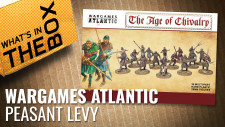













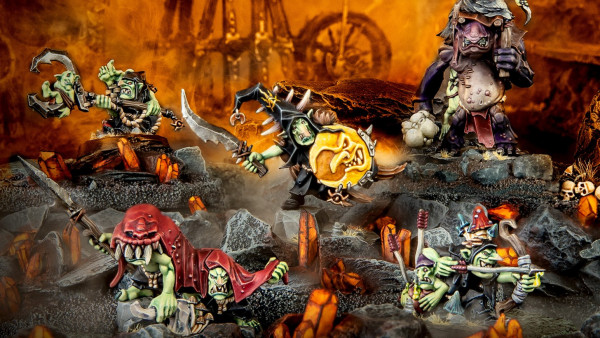

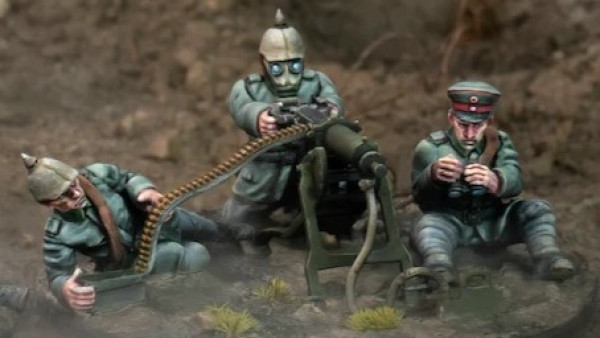

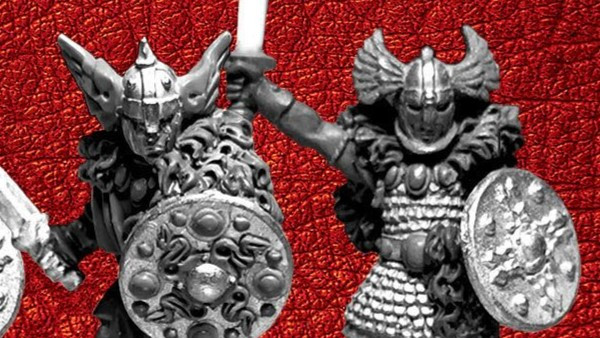
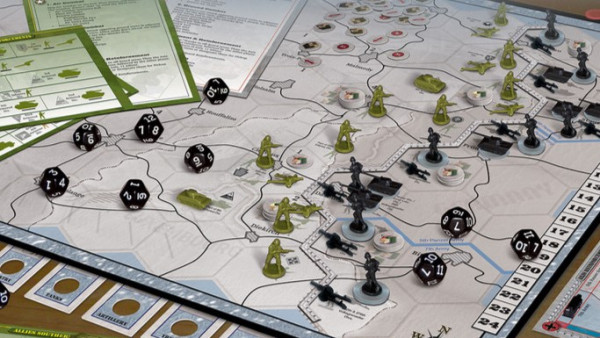

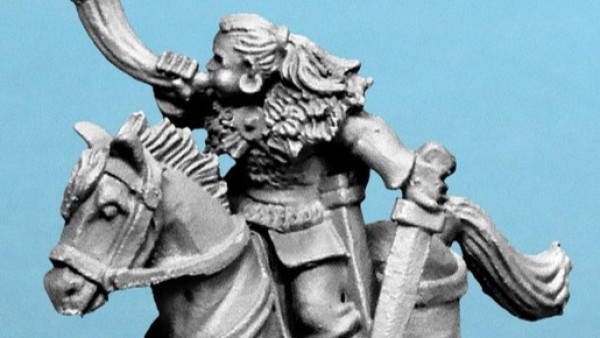




















A couple of interesting ships, especially the arrangement of the secondaries on the Gettysburgs. Will need to remember that if I cross swords with one.
Looks like the hybrid carrier idea works a bit better than it did for real water bourne navies, judging by the recent Arab League battle performances.
Thanks, @damon . Yeah, the secondary battery layout is an idea I’ve been playing around with for battleships, this is the first time I’ve really tried it with a heavy cruiser. I don’t know if it really worked. I mean, the destroyer Samarra broadsided USS Shiloh’s stern point blank, and took a pounding, but survived the whole battle. Then again, it wasn’t the Samarra that ultimately crippled the Shiloh. It’s definitely more important with these “Pacific layout” ships (main armament = three triple turrets, two forward). They can put good firepower forward on initial approaches but are pretty vulnerable to… Read more »
I agree that primaries forward and secondaries aft makes a lot of sense for the big ships. Smaller more nimble ships will be wanting to get a good angle on the stern up close to hit something vital. I was wondering when you design a vessel with numbers of guns/turrets/mounts. Does the layout of the ship class limit how many weapons are in what positions? To prevent just putting all guns bow or aft to enable perfect broadsides every time? As for the hybrid ships I think the Damascus will work well as it has the torpedoes to add cover… Read more »
Great questions @muakhah Turret layout / geometry: nothing in the design tables or rules prevents what you’re talking about (all guns at Bow and Stern locations for perfect broadsides). In fact, dozens of warship classes do exactly this in Darkstar (leaving aside mass drivers). However, there are reasons NOT to do this, especially with larger vessels. 1) it’s cheesy for larger vessels. 😀 2) Your weapons are vulnerable when you put too many of them in one place. For most warship types (not classes … so “frigate”, “destroyer”, “light cruiser”, etc), the WRS is designed with two weapons locations fore… Read more »